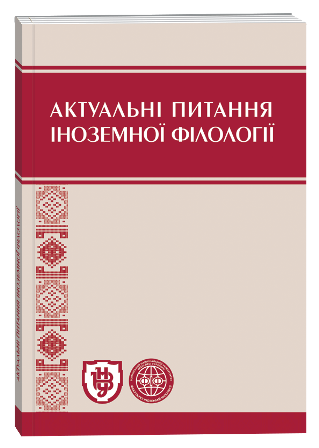SYNTECTIC NONCANONICAL AS A MARKER OF EMOTIONAL SPEECH: UKRAINIAN AND GERMAN SOURCES
DOI:
https://doi.org/10.32782/2410-0927-2022-16-20Keywords:
expressive syntaxes, emotion, the size of syntactic units, incomplete sentence, emotional intensity, sequence of thoughtAbstract
The issue about the expediency of comparative research as for categories of emotiveness at the synthetic level is study in the given article based on cinematographic materials and emotional dialogues from German and Ukrainian original telenovels mentioned as perspective linguistic text massive (“Sturm der Liebe”, “Alisa – folge deinem Herzen”, “Wege zum Glück, Spuren im Sand” and «Тільки кохання», «Дві матері», «Обручка з рубіном» (12 000 setncences, about 70 000 words)). The aim of the research is to discover and compare mechanisms of implementations of emotive potentials at the synthetic level in movie dialogues from German and Ukrainian original telenovels. The research is based upon methods of linguistic description, system, component and quantified analysis, methods of interpretation and comparison. The analysis is done at the perfunctory structural, stylistic, and syntactic levels. In both languages the particularity of different short and long emotive sentences is studied and the pattern of sentence dependence upon their length and emotional intensity together with emotive sign are established. Basing on the given materials the analysis of simple and completed sentences is done focusing on sentences which stray from two-part structure, the most often models for Ukrainian and German movie dialogues are established depending on the tendency to reduction of principal part of the sentence. During the analysis of non-two-part sentences the attention is drawn on significant difference between non-two-part sentences and incomplete or interrupted sentences. Except of the perfunctory structural noncanonical as the reduction of syntactic complementation in sentences, existence of non-two-part, elliptical, incomplete, or interrupted sentences, having our material based different types of comparison (epiphorical, anaphorical and frame repetitions, anadiplosis) are considered together with (emphatic) inversion, comparison, technique of pressurization and parcelling. Moreover, the tends to both parceling of different parts of the sentence and parceling of sentences as parts of co-ordinated ones are also determined.
References
Волокитина А. И. Соотношение коммуникативного и структурного планов в порядке слов немецкого языка. Саратов : изд. Саратовского университета, 1969. 254 с.
Девкин В. Д. Немецкая разговорная речь. Синтаксис и лексика. М. : Международные отношения, 1979. 254 с.
Каушанская В. Л. Грамматика английского языка. М. : Просвещение, 1973. 320 с.
Кострова О. А. Экспрессивный синтаксис современного немецкого языка. М. : Флинта, 2004. 240 с.
Лагутин В. И. Проблемы анализа художественного диалога. Кишинев, 1991. 98 с.
Лебедев В. Б. Об одной структурной особенности немецкой диалогической речи. Ученые записки Горьковского государственного педагогического института. Вып. 30. Волго-вятское изд-во, 1976. С. 231–240.
Орлова Н. Н. Языковые средства выражения эмоций: синтаксический аспект (на материале современной английской прозы) : дис. … канд. фил. наук: 10.02.19, 10.02.04. Ростов-на-Дону, 2009. 188 с.
Сидоренко І. А. Повтор як ключовий принцип функціонування стилістичних фігур сучасних англомовних драматичних творах. Актуальні проблеми романо-германської філології та прикладної лінгвістики. Збірник наукових праць Чернівецького нац. унів. ім. Ю. Федьковича. Чернівці, 2017. С. 252–263.
Скалкин В. Л. Обучение диалогической речи. Киев : Радянська школа, 1989. 157 с.
Чабаненко В. А. Стилістика експресивних засобів української мови. Запоріжжя : ЗДУ, 2002. 352 с.
Шендельс Е. И. Грамматика немецкого языка. М. : 1974. 366 с.
Шипова И. А. Эмоциональный синтаксис в немецкоязычном художественном дискурсе : дис. … канд. фил. наук: 10.02.04. М., 2005. 230 с.
Fiehler R. Syntaktische Phänomene in der gesprochenen Sprache. Handbuch “Satz, Äußerung, Schema”. Berlin/Boston : de Gruyter, 2015. S. 370–395.
Fiehler R. Angewandte Diskursforschung. Neuauflage Radolfzell : Verlag für Gesprächsforschung, 2002. B. 2. S. 18–35.
Günthner S. Praktiken erhöhter Dialogizität: onymische Anredeformen als Gesten personifizierter Zuwendung. Zeitschrift für germanistische Linguistik. 2016. 44 (3). S. 406–436.
Hoffmann L., Ziffonum G. Strecker B. Grammatik der deutschen Sprache. Verlag W de S, Berlin, 1997. 952 s.
Kailuweit R. Syntax und Semantik französischer und italienischer Gefühlsverben. Tübingen : Niemeyer Verl., 2005. 372 s.
Kelih E, Grzybek P. Häufigkeiten von Satzlängen: Zum Faktor der Intervallgröße als Einflussvariable (am Beispiel slowenischer Texte). Glottometrics 8. 2004. S. 23–41.
Osterroth А. Der Einfluss der synchronfassungen massenmedialer Produkte auf den Sprachwandel am Beispiel des Lexems Nerd. Sprachreport, 31 (2015), 3. URL: https://core.ac.uk/download/pdf/83653824.pdf
Schreiber M. Textgrammatik – gesprochene Sprache – Sprachvergleich: Pronomen im gesprochenen Französischen und Deutschen. Frankfurt am Main : Lang, 1999. 537 s.
Weinrich H. Textgrammatik der deutschen Sprache. Georg Olms Verlag, Zürich, 1990. 1111 s.







